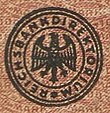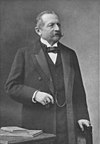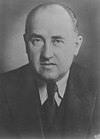Reichsbank
This article needs additional citations for verification. (January 2008) |
| |||
| Headquarters | Reichsbank building, Berlin | ||
|---|---|---|---|
| Established | 1 January 1876 | ||
| Ownership | Government owned | ||
| Präsident der Reichsbank | See list | ||
| Central bank of | German Empire Weimar Republic Nazi Germany | ||
| Currency | Reichsmark | ||
| Succeeded by | Bank deutscher Länder (West) Deutsche Notenbank (East) | ||


The Reichsbank (![]() listen (help·info)) (“Bank of the Reich”, lit.: “Bank of the Realm”) was the central bank of the German Reich[1] from 1876 until 1945.
listen (help·info)) (“Bank of the Reich”, lit.: “Bank of the Realm”) was the central bank of the German Reich[1] from 1876 until 1945.
History until 1933[]
The Reichsbank was founded on 1 January 1876, shortly after the establishment of the German Empire in 1871. It was the central bank of Prussia, under the close control of the Reich government.[2] Its first president was Hermann von Dechend. Before unification in 1871, Germany had 31 central banks – the Notenbanken ("note banks"). Each of the independent states issued their own money. In 1870, a law was passed that forbade the formation of further central banks. In 1874, a draft banking law was introduced in the Reichstag, the federal legislature of the German Reich. After several changes and compromises, the law was passed in 1875. Despite the creation of the Reichsbank, however, four of the Notenbanken – Baden, Bavaria, Saxony and Württemberg – continued to exist until 1914[citation needed] .
The Reichsbank experienced both stable and volatile periods[citation needed] . Until World War I, the Reichsbank produced a very stable currency called the Goldmark. The expenses of the war caused inflationary pressure and the mark started to decrease in value[citation needed] . The defeat of Imperial Germany in 1918, the economic burden caused by the payment of war reparations to the Allies, and the social unrest in the early years culminated in the German hyperinflation of 1922–23[citation needed] ]. The mark, formerly backed by gold, evolved into the Papiermark (paper mark), backed by nothing[citation needed] .
Economic reforms, such as the issue of a new provisional currency – the Rentenmark – and the 1924 Dawes Plan, stabilised German monetary development and thus the economic outlook of the Weimar Republic. One of the key reforms caused by the Dawes Plan was the establishment of the Reichsbank as an institution independent of the Reich government. On 30 August 1924, the Reichsbank began issuing the Reichsmark, which served as the German currency until 1948.[citation needed]
Nazi period[]


The seizure and consolidation of power by the Nazis during the years of the Third Reich also greatly affected the Reichsbank. A 1937 law re-established the Reich Government's control of the Reichsbank, and in 1939, the Reichsbank was renamed the Deutsche Reichsbank (“Bank of the German Reich”, lit.: “Bank of the German Realm”) and placed under the direct control of Adolf Hitler, with Walther Funk as the last president of the Reichsbank, from 1939 to 1945.[3] The bank benefited by the theft of the property of numerous governments invaded by the Germans, especially their gold reserves and much personal property of the Third Reich's many victims, especially the Jews. Personal possessions such as gold wedding rings were confiscated from prisoners, and gold teeth torn from dead bodies, and after cleaning, were deposited in the bank under the false-name Max Heiliger accounts, and melted down as bullion. The defeat of Nazi Germany in May 1945 also resulted in the dissolution of the Reichsbank, along with other Reich ministries and institutions. The explanation of the disappearance of the Reichsbank reserves in 1945 was uncovered by Bill Stanley Moss and Andrew Kennedy, in post-war Germany. In April and May 1945, the remaining reserves of the Reichsbank – gold (730 bars), cash (6 large sacks), and precious stones and metals such as platinum (25 sealed boxes) – were dispatched by Walther Funk to be buried on the Klausenhof Mountain at Einsiedl in Bavaria, where the final German resistance was to be concentrated. Similarly, the Abwehr cash reserves were hidden nearby in Garmisch-Partenkirchen. Shortly after the American forces overran the area, the reserves and money disappeared.[4] Funk would be tried and convicted of war crimes at the Nuremberg trials, not least for receiving money and goods stolen from Jewish and other victims of the Nazi concentration camps. Gold teeth extracted from the mouths of victims were found in 1945 in the vaults of the bank in Berlin.[citation needed]

The Allied occupation authorities (in the West – Great Britain, France and the United States; in the East – the Soviet Union) became responsible for German monetary policy in the immediate postwar years. In this role, the Allies continued to issue Reichsmarks (and Allied military marks) as the German banking system was gradually restored. In 1948, the Reichsmark ceased to exist owing to the introduction of the Deutsche Mark in the West and the East German mark in the East. In West Germany, monetary policy was taken over by the Bank deutscher Länder (Bank of the German States) and later by the Deutsche Bundesbank. In East Germany, this role was assumed by the Deutsche Notenbank (later renamed as the Staatsbank der DDR (State Bank of the German Democratic Republic).
Reichsbank presidents[]
| No. | Picture | President of Reichsbank | Took office | Left office | Time in office |
|---|---|---|---|---|---|
| 1 | Hermann von Dechend (1814–1890) | 1876 | 1890 | 13–14 years | |
| 2 | (1834–1910) | 1890 | 1908 | 13–14 years | |
| 3 | Rudolf Havenstein (1857–1923) | 1908 | 11 November 1923 | 14–15 years | |
| 4 | Hjalmar Schacht (1877–1970) | 12 November 1923 | 6 March 1930 | 6 years | |
| 5 | Hans Luther (1879–1962) | 7 March 1930 | 17 March 1933 | 3 years | |
| (4) | Hjalmar Schacht (1877–1970) | 18 March 1933 | 19 January 1939 | 5 years | |
| 6 | Walther Funk (1890–1960) | 20 January 1939 | 8 May 1945 | 6 years |
References[]
- ^ Budzinski, Prof Dr Oliver. "Definition: Reichsbank". https://wirtschaftslexikon.gabler.de/definition/reichsbank-43311 (in German). Retrieved 2020-01-06. External link in
|website=(help) - ^ Money and Banking
- ^ Shirer, William L. The Rise and Fall of the Third Reich. Greenwich: Fawcett Publications, 1959. 360.
- ^ Moss, W. Stanley, Gold Is Where You Hide It; What Happened to the Reichsbank Treasure?, Andre Deutsch 1959
External links[]
 Media related to Reichsbank at Wikimedia Commons
Media related to Reichsbank at Wikimedia Commons- Documents and clippings about Reichsbank in the 20th Century Press Archives of the ZBW
- Banks of Germany
- Banks established in 1876
- 1945 disestablishments in Germany
- Economy of the German Empire
- Former central banks
- Economy of Nazi Germany
- German companies established in 1876







